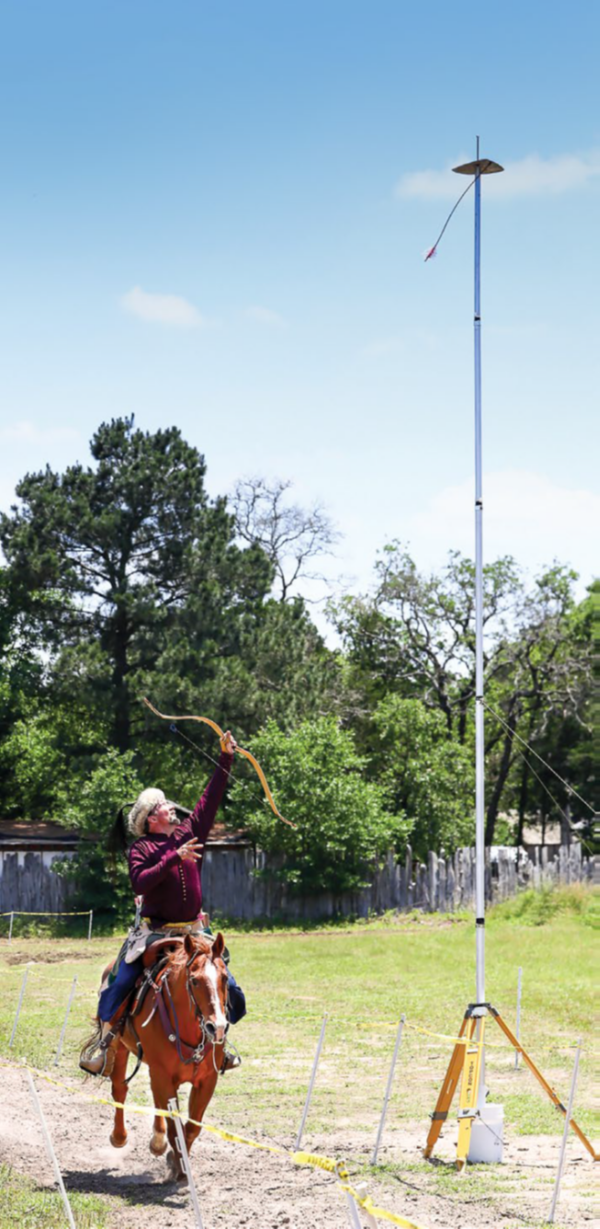
In the 13th century, Genghis Khan, an illiterate horseman with a relatively small army, conquered the largest consolidated land empire in history. At its peak, the Mongol Empire covered some nine million square miles (23 million sq km) of territory, and it was captured by a force of almost entirely horse archers.
Some of the Mongols’ “secret” weapons were innovative — advance and retreat warfare tactics, incredible amounts of practice and the invaluable invention of steel stirrups, which provided a stable platform needed for the horse archers to stand in their stirrups and shoot at the enemy, even while retreating.
For over the past 800 years in many parts of the world, the requisite skills required of horse archers are still practised, especially in China, Japan, and Mongolia. Here in North America, the “most feared invaders” tactics have been transformed into a sport and are enjoying an upsweep in popularity.
Unlike many equine-based events, in mounted archery, the majority of the work, skill and training is placed on the rider. Hours and hours of practice and competent coaching is needed to accurately fire a horse bow, let alone fire an arrow hard enough to embed it in a target. From there, the enthusiast graduates to nocking the arrow and shooting from the back of a walking horse. As their skills increase, so does their speed.
While becoming a competent archer is paramount, so is training the horse to respond directly to knee and leg pressure. The sport is conducted without the use of reins, as the archer is too busy rapidly shifting position while nocking and firing arrows at a myriad of targets on either side, overhead (called qabaq) and behind the rider along the staked-out course.

North of Olds, Alta., is the Kaspian Equestrian Training Centre, located on the Rock–N–Rail Ranch. The multi-zone equine facility includes a massive, spotless arena, outdoor pens and rings that run the gamut from sand to grass, and pristine barns and outdoor pens. Kenton Miller built the place literally from scratch, and the facility offers boarding as well as instruction and coaching in working equitation, dressage and mounted archery.
Kenton, himself an international competitor who recently was crowned the Overall Champion of the 2019 Texas International Archery Festival, is as enthusiastic as he is skilled. The archery club has attracted a broad cross-section of people whose skills have rapidly gone from “How to Hold a Bow” to scary-good shots. Kenton is a precise coach heavily laced with kindness. He is encouraging to newcomers, and clearly enjoys teaching and watching his students progress.
Kenton is also an enthusiastic and popular international competitor who takes pride in his skills and his appearance, paying homage to the great horse archers before him. His horsemanship is as exacting as his shots on target, and the combination has earned him many awards.
In a nutshell, horse archery is a martial art — and like all martial arts it’s not easy.
However, if it’s worthy of your pursuit and if you have the passion to develop the skills, then this might be the game for you — a sport that has literally won empires.

FIND A CLUB
In Canada, mounted or horse archery clubs affiliated with Canadian Federation of Mounted Archery exist in B.C., Alberta, Ontario and Nova Scotia, while internationally, there are clubs in Austria, Belgium, Brazil, Britain, Bulgaria, China, Finland, France, Germany, Greece, Hungary, Japan, Jordan, Russia, Korea, Luxembourg, Malaysia, Mongolia, Norway, Poland, Qatar, Romania, Russia, South-Africa, The Netherlands, Ukraine and USA.
To learn more about the sport, visit KaspianEquestrian.com. To find a club near you or internationally, visit Canadian Federation of Mounted Archery at canadian-federationof-mounted-archery.com or the International Horse Archery Alliance at horsebackarchery.info.
POSTAL MATCHES
Because the horse archery clubs are spread out and it’s difficult to travel abroad to compete in person, the International Horseback Archery Alliance have created a postal match series to keep the enthusiasm high and give competitors an idea of how they are progressing.
To participate in a postal match, a club sets up the required course, timers record the times and scores are recorded. Participants shoot the number of runs required and the scores are submitted online. This way, archers can compete at their local club and on a familiar horse. There are no prizes, but it is a verifiable record of a shooter’s progress as an archer.
Each match is set by a club from the affiliated nations. All postal matches have Walk, Trot and Canter divisions.
NOCK, NOCK, NOCKING…
Specialized equipment ranges from horse bows to quivers, thumb guards to arrows. Some clubs will have equipment for a beginner to try or even rent long-term. As with all specialized equipment, try before you buy as each archer will find an affinity for a specific type of bow, whose design goes back thousands of years. Modern arrows are made of fibreglass, and many are custom-made. In contrast, the unusual quivers that hold the arrows on the thigh or the back are leather and often elaborately decorated.
Website Extras:

























